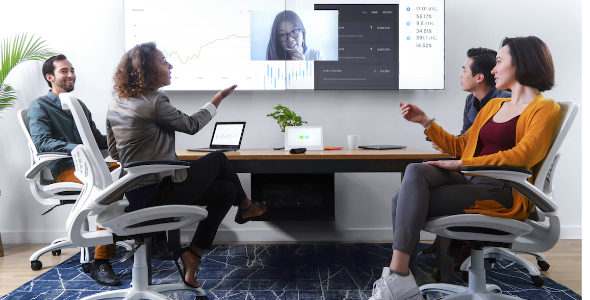
Certainly, the name lends itself to huge LED panels, cinematic projectors and sound quality that transports you to the music studio. But whilst these “traditional” use cases are continuing to be innovated on and sold, it is the enterprise applications that are keeping the industry churning.
Speaking at InfoComm 2019, Avixa senior director of communications Brad Grimes said that growth in the audio-visual industry has come as a result of a change in attitudes of C-level executives, bringing them into the scope of their IT departments.
“AV has traditionally not been a part of IT but that’s changed in the last few years.
“More and more AV is being rolled into IT networks and has become an enterprise technology. Especially in terms of UC, video conferencing, that is an enterprise application now, it is an audio-visual application.
“Some of these applications are very enterprise focussed and C-suite executives have put it on their radar which has really what has juiced the rate of growth in the industry. It has become something that organisations no longer see as a nice to have anymore; you got to have it now.”
Obviously, the main use case for AV solutions in the enterprise in for video conferencing. The popularity of meeting room solutions from Zoom, BlueJeans and Webex (other solutions are available) is testament to that and I’d bet that this week, depending on where you work and who you are doing business with, you’ll have some invites with dial-in information and meeting numbers to recite.

Zach Bosin points out that these solutions are also being use to connect more workers and allow them to contribute to a meeting no matter the situation or location.
“We’ve seen some use cases in the retail sector where those folks don’t have a lot of infrastructure but at the same time, they want to share pictures of their merchandising and share best practice with other stores.
“Therefore, having iOS screensharing allows them to do that just as they would if they had a traditional office set up.”
Bosin went on to say that the mobile integration as well features such as ‘raise your hand’ in its Events proposition encourage engagement from all employees; a sentiment echoed by the likes of Oblong.
“What you’re really trying to do if you’re an executive is not just trying to give a lecture, you’re trying to engage your audience trying to have them ask questions, trying to have them build culture.
“So, we’re trying to invest in all these different features like translate to make them feel like they are part of the whole company.”
David Kung VP Product Strategy at Oblong agreed with Bosin’s comments adding that “Unfortunately a lot of the time when we say collaboration, it’s really just communication.
“That is important, I’m not trying to discount it, but it will only get you so far. How do you get people to actively engage or give them the tools to participate even when they are on mute?”
Kung said that the motivation behind introducing features like reactions, annotations and gestures into its Rumpus platform that is overlaid on Blue Jeans and Webex calls, was born out of an attempt to boost the engagement from everyone on the call rather than a couple of protagonists.
“A lot of the time people get on an audio conference call and they just look at a document that was emailed out the night before or look at a shared document. Well now you can do that within rumpus and get all the benefits of multiple streams of content that can be shared, of real-time annotation and of emotional reaction from everyone.”
“With interactions we can take meetings that were just presentations and turn them into collaborations where your content becomes the centre of that collaboration. That helps the remote workers get a seat and a voice at the table on an equal playing field.”
Although video conferencing may be seen, largely, as the next best thing to a physical meeting, camera quality and field of view go a long way to a successful session according to Logitech Head of analyst relations and sales enablement Simon Dudley.
Speaking to CommsBusiness at InfoComm19, he said that, to paraphrase Ronan Keating, sometimes we say more when we say nothing at all.
“With our cameras now, you can have six people in a really small room, wedge them in and they’ll never be out of shot. And think does it matter?
“Well actually if I’m on a video call, those people at the far end of the video call may not be really interested in what I have to say. But, importantly, I want to see how they are reacting to what I’m saying because they’re saying lots with your body language.
“That may be ‘would he just shut up and answer my question or move on or do something else’ but I want to know that because otherwise I’m not getting the power of video, I might as well go back to an audio call.”
Kung added: “One of the things we lost when we went to virtual meetings was non-verbal communications.
“If you think about it anytime we are communicating the voice part is actually one of the smallest pieces of what drives effective collaboration. Simple things like seeing a cursor is like a gesture, placing an emoji is like seeing a facial reaction and by giving people that back we are hoping we can give back the high level social and human connections and ultimately that’s what drives high performing teams.”

Figures from Avixa indicate that these approaches are striking a chord with the industry.
According to the trade body, the AV industry is growing twice as fast as Global GDP, equating to around five to six percent, a figure that, depending what sector you look into, can increase up to nine percent.
However, Grimes did admit that margins have shrunk in the last decade, prompting the new method of selling that we see today.
“Even 10 years ago margins were great, great double-digit margins on these solutions but because a lot of the boxes, displays and wires, have become so commoditised there has to be another way to build value.
“Now, companies are talking about solutions and figuring out how we put this together. Vendors are not just giving you a display and a video conferencing codec anymore; they are providing a collaboration solution.”
As for InfoComm, Grimes says that the priority for Avixa is to continue to show off the latest AV innovations and invite more industry sector leaders to see the value and efficiencies that these solutions can provide.
“For many years this has been very much an AV Channel show. You have the manufacturers of displays and speakers, you have the dealers who would sell them you have the consultants who inspect them, the installers who would install them. That was the large part of this show.
“But there is only so far you can take that. For the last 10 years, we have been actively trying to get the end customers of those solutions here and trying to increase awareness in different markets that this exists and that there is strategic value to some of this technology.
“We believe that is the biggest opportunity for us to grow the industry overall. Leaders in new markets need to understand that there is business value to this kind of stuff.
“AV can’t just be seen as a nice to have, it needs to change the way you do business, change the way you operate, allow you to operate better and affect the experience in your store, in your hotel or in your restaurant.”
